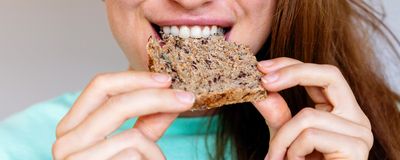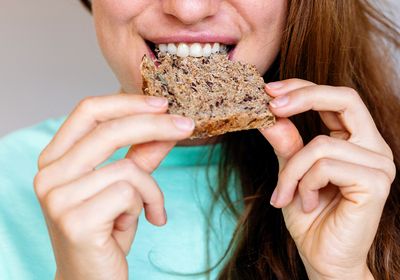ABOVE: Proteins in human spit break down starches into sugars. ©istock,Igor Barilo
Although humans can produce as much as 1.5 liters of saliva every day, most people don’t give spit a second thought. But spit—and more specifically the proteins it contains—has an important yet incompletely understood relationship with pathogens and with the energy-rich biological molecules in food. As such, said Omer Gokcumen, an evolutionary anthropologist at the University at Buffalo, “It’s actually a hotbed of evolution.”
One such example of spit’s evolutionary weirdness is the AMY1 gene, which encodes a starch-digesting salivary protein called amylase. Millions of years ago, a common ancestor of humans and chimpanzees had just one copy of AMY1 per chromosome, or two per diploid cell. Since then, AMY1 has gotten a bit out of hand: Modern humans can have anywhere between two and 17 copies.1 “That's almost unheard of for a functional region,” said Gokcumen. “You see that kind of variation only in regions where [the DNA] doesn't do anything.” Furthermore, said Gokcumen, when a gene duplicates and remains intact, it often undergoes neofunctionalization, gradually acquiring mutations until it can perform a new function. However, AMY1 remains essentially the same no matter how many times it duplicates.
For the past several years, Gokcumen and his team have been exploring the how, when, and why of AMY1 copy number variation. In a new genomic analysis of modern and archaic humans published in Science, the researchers reconstructed this region in greater detail across a variety of individuals, providing new insights into the mutational mechanisms at play and rewriting the timeline of AMY1 expansion.2
Historically, the similarity between AMY1 copies has made this stretch of the genome difficult to map with traditional short-read sequencing techniques like sequencing by synthesis, which map out chunks of DNA that are 50-300 base pairs long. Gokcumen likens this approach to assembling a puzzle of an abstract painting: a task that is nearly impossible when there are many tiny pieces, but much easier if there are relatively few larger pieces. In this study, researchers used more recently developed long-read sequencing methods—which can sequence sections of DNA that are tens of thousands of base pairs long—to map this region of the genome with nucleotide-level precision.
This study has shed light on the mechanisms driving the development of this genomic oddity: Islands of similar sequences within the region of the genome that encodes for this salivary protein increase the likelihood that the cell will make an error when recombining chromosomes during meiosis, the process of scrambling maternal and paternal chromosomes to create a population of genetically diverse eggs or sperm within a single individual. This type of error, called non-allelic homologous recombination, can result in genetic duplications or deletions, and likely underlies the wide range of genetic copies seen across individuals.
Gokcumen’s research has also provided new insights into when exactly in human history AMY1 started duplicating. Human diets began to shift towards starch-rich foods around 12,000 years ago with the advent of agriculture, but Gokcumen’s work suggests that the duplications originated long before then. By analyzing public datasets, his team found evidence that ancient hominins, such as Neanderthals and Denisovans, also had increased AMY1 copy numbers; the researchers suggest that multiple copies may have evolved as early as 800,000 years ago. This parallels other lines of evidence that indicate that early humans consumed at least some starch, in the form of wild plants, in pre-agricultural times.3
The transition towards agriculture is still linked to AMY1 expansion, however. Compared to pre-agricultural European genomes, the genomes of individuals that lived after agriculture became ubiquitous across Europe generally had more copies of the AMY1 gene. There is further evidence that diet is linked to these genomic changes. As human diets became more starch-rich, so too did the diets of animals closely associated with humans: Dogs, pigs, mice, and rats all independently evolved multiple copies of amylase-encoding genes.4
All this suggests that having more AMY1 copies is beneficial for mammals that consume a lot of starch, but oddly, scientists still haven’t determined exactly how multiple copies of a salivary amylase gene might confer an evolutionary advantage. “If you don’t have salivary amylase, in theory, you can still eat bread without any problems,” said Gokcumen. “You can still digest it, you still get the calories.” This is thanks to AMY2, a gene expressed in the pancreas: This version of amylase gets secreted into the small intestine, where the majority of starch digestion occurs.
“So, now the question is: What’s up with salivary amylase?” Gokcumen said there are several hypotheses. First, and perhaps most often cited, is that getting a jump start on digestion may enable people to extract more calories from the starches they consume, but this has never been conclusively proven and research on the association of AMY1 copy number with obesity has produced mixed results.5
It's also possible that the benefits of salivary amylase are conferred through taste, rather than pre-digestion. Humans don’t have a taste receptor for starch, said Gokcumen. Instead, people have sugar receptors. Therefore, breaking down starches into sugars in the mouth may improve the taste, and therefore the preference, for carbs. In a time where getting enough calories was a challenging task, those who chose to consume high-energy starches may have fared better than their neighbors. This sweet taste could also help the body prepare for what’s to come, adjusting metabolic and digestive processes to anticipate the incoming meal.6
Gokcumen plans to explore these hypotheses in the future, using enzymes in people’s spit as a window into the complex evolutionary history of humans.
- Perry GH, et al. Diet and the evolution of human amylase gene copy number variation. Nat Genet. 2007;39(10):1256-1260.
- Yilmaz F, et al. Reconstruction of the human amylase locus reveals ancient duplications seeding modern-day variation. Science. 2024;386(6724):eadn0609.
- Cristiani E, et al. Wild cereal grain consumption among Early Holocene foragers of the Balkans predates the arrival of agriculture. eLife. 2021;10:e72976.
- Pajic P, et al. Independent amylase gene copy number bursts correlate with dietary preferences in mammals. eLife. 2019;8:e44628.
- Rukh G, et al. Dietary starch intake modifies the relation between copy number variation in the salivary amylase gene and BMI. Am J Clin Nutr. 2017;106(1):256-262.
- des Gachons CP, Breslin PAS. Salivary amylase: Digestion and metabolic syndrome. Curr Diab Rep. 2016;16(10):102.




